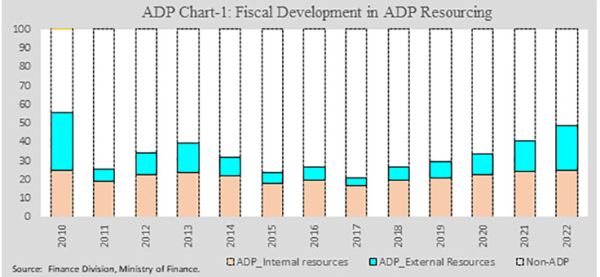Annual Development Programme
Annual Development Programme (ADP) an organised list of projects in various sectors and allocations for them for a year out of a five-year plan period for implementation of the government's development policies, programmes and investments in the plan. The ADP is prepared on the basis of the year's development budget approved by the parliament.
The planning commission formulates the ADP of the government of Bangladesh in the light of basic objectives and goals stated in a Five-Year Plan. The draft is then placed for the approval of the Executive Committee of the national economic council (ECNEC). While preparing an ADP, fields and projects related to national economic development get more priority and concentration. Funds are allocated to implement development projects included in the ADP. Both internal (domestic) and external (aid) funds are used to finance projects. Potential availability of funds often becomes a major consideration in preparing the ADP, which has historically remained dependent upon foreign aid.
The practice of formulating ADP by splitting a Five-Year Plan and implementation thereof started since the First Five-Year Plan (1955-60) of the provincial government of East Pakistan. The size of the ADP of the year 1962-63 under the Second Five-Year Plan (1960-65) of the government of East Pakistan was Rs 1,358.33 million. The ADP for 1962-63 was divided into three parts, each with projects of a group of sectors. Part-I included projects of 10 sectors, namely Water, Power, Health, Social Services, agriculture, housing and Settlement, Education and Training, Roads and Communications, Industries, and Manpower and Employment. Projects in Part-II covered large industries such as the East Pakistan Industrial Development Corporation and Pakistan Eastern Railways and Part-III comprised schemes transferred from the central government of Pakistan.
Composition of ADP demonstrated some changes in the first ADP (1965-66) of the Third Five-Year Plan (1965-70). The ADP of the year 1965-66 did not have the different parts and comprised projects grouped in 12 sectors in a new order with a total allocation of Rs 1,951.30 million. The sectors were Water, Power, Agriculture, Industries, Fuel and Minerals, Transport and Communications, Physical Planning and Housing, Education and Training, Health, Social Welfare, Manpower and Employment, Survey and Statistics, and Works.
In 1972-73, the size of the ADP was Tk 5.01 billion, 75% of which was supported by foreign aid. The ADP size has grown consistently over the years and became Tk 9.5 billion in 1975-1976, Tk 21.23 billion in 1979-1980, Tk 50.46 billion in 1987-1988 and Tk 121.00 billion in 1995-1996. The ADP remained heavily dependent upon foreign aid. The share of foreign funds in financing ADP allocations was more than 70% until 1979-1980; it dropped to about 64% in the following two years and then again increased to about 80% in the next three years. The share was more than 90% in the years 1987-1988 and 1990-1991. However, it started to decline in successive years and was 66% in 1995-1996. The annual development programme for 2000-2001 was allocated at Tk. 175 billion, of which 43% was financed through foreign aid and loans. In FY 2011, 25.4% of the total annual development programme was supported through foreign loans and grants. However, the foreign finance of ADB rose to 40.6% in FY 2021 and it is estimated to be 48.6% for FY 2022 (see Chart 1).

From the above chart, we can see that the contribution of internal resources to ADP has increased significantly. Continuing this trend of resource allocation from domestic sources might accelerate overall economic growth and development. On the other hand, external sourcing is not that much comparative to internal sourcing except two financial years FY 2010 and FY 2022.
The government has a practice of revising the ADP almost every year and the main reason is the failure to receive disbursements of the foreign aid in a general management environment of poor foreign aid utilisation. Sometimes, the government changes the ADP by inclusion of new or exclusion of some listed projects in the midst of the year. More often, delays in approval of projects or in creation of appropriate infrastructure facilities for them cause such revisions. Other causes for revision include procurement related problems and shortage of taka counterpart fund for the projects. There are cases, when the ADPs are revised in favour of increasing allocations in response to claims of the implementing ministries/agencies for additional allocation of both local and foreign currencies. Note that it is not possible to include all projects in a particular year in ADP. Certain projects are kept out of ADP and are implemented through allocation of funds from the revenue budget of a particular year. The Ministry of Finance announces specific policies for the implementation of all projects. The implementation process of the projects is monitored by the Ministry in the light of the policy.
Every year the quantum of allocation in the annual development programmme is being increased on the ground of particular national strategy in relation to eco-social and infrastructural development of the country, human resource development, reduction of poverty and enrichment of income.
The total amount of ADP is Tk. 2.21 trillion in FY 2021. The sectors, including the share of allocations to the development sector in FY 2021, are Transport and Communication (25.2%), Education and Technology (19.4%), Local Government and Rural Development (15.7%), Electricity and Fuel (12.4%), Agriculture (5.5%) and Social Security and Welfare (3.1%). In addition, 7.1 percent has been allocated to other sectors. The government is set to approve a Tk. 2.46 trillion annual development programme (ADP) for the next fiscal year (FY) 2022-23, aiming to facilitate quick recovery of the economy from the disaster of the pandemic. [Abul Kalam Azad]
